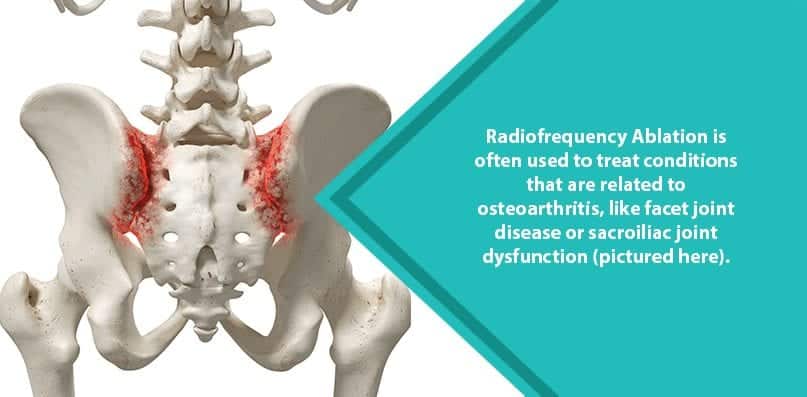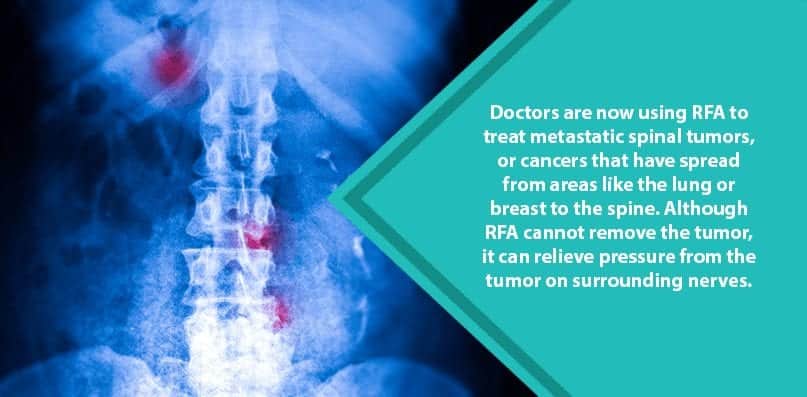What Does “Radiofrequency Ablation” Mean?
Radiofrequency Ablation, or RFA, goes by many names: Rhizotomy, Radiofrequency Neurotomy, or Lesioning.
But, don’t let all of the fancy terminologies fool you. The procedure is actually quite simple. In fact, the gist of the procedure is embedded in the name. Ablation means to remove by means of intense heat or vaporization. And, Radiofrequency refers to the type of energy waves that your doctor will use to generate this heat.
Hence, RFA involves using radiofrequency waves to burn, or lesion, a problematic area on a nerve. When the nerve tissue is damaged or “stunned” by heat, it can’t send pain signals to your brain any longer. As such, patients who undergo RFA often report feeling instantaneous relief after receiving their injection.
Although disabling this brain and body connection may sound extreme, it’s actually quite effective—and relatively risk-free.

What Conditions is Radiofrequency Ablation Used to Treat?
Historically, doctors have used RFA to treat two specific types of conditions that result from osteoarthritis: Facet Joint Pain and Sacroiliac Joint Dysfunction.
- Facet Joint Pain: Located on the back side of your spine, your facet joints serve as the point of connection between two adjacent vertebrae. Whenever you move or articulate your spine, your facet joints allow for this movement. Because your facet joints are constantly involved in adjusting your posture, they tend to suffer from quicker-than-average levels of wear and tear. As the cartilage that lines these joints breaks down, the amount of space reserved for the nerves around our spine also shrinks. As our nerves become pinched, symptoms of nerve pain, like tingling and muscle spasms, can emerge.
- Sacroiliac (SI) Joint Dysfunction: SI Joint Pain occurs when the joint that connects the sacrum to the ilium (or hip bone) becomes inflamed. As with the facet joints, osteoarthritis often attacks the hips. As the cartilage and ligaments that support the hip wear down, the nerve-rich SI joint can suffer compression. When simple nerves blocks for SI joint pain fail to provide adequate relief, you may need a more aggressive approach, like RFA, to jumpstart your recovery process.
Have you been suffering from chronic hip or lower back pain? If traditional pain relief methods, like pain medications, have not worked for you, then contact a board-certified orthopedic surgeon. A qualified orthopedist can help you diagnose the source of your pain and suggest minimally invasive treatments, like RFA.
How is Radiofrequency Ablation Performed?
To determine if you need RFA, your doctor will likely perform a series of diagnostic injections first. These procedures are known as Facet Blocks or SI Joint Block injections. If your doctor delivers anti-inflammatory medication directly into your joint and your pain abates, then your doctor can conclusively determine that you have facet joint or SI joint pain.
Equipped with a correct diagnosis, your doctor will give you clearance to undergo RFA. During an RFA, your doctor will offer you gentle sedation via an intravenous (iv) line. (Your doctor will deliver this medication to help relax your nerves — ie, the jittery kind.) Then, your doctor will inject a local anesthetic into the RFA site. This numbing medication ensures that you will not experience any pain during the procedure.
Using fluoroscopy (or live x-ray technology), your doctor will guide the needle and electrodes near the target nerves. Specifically, the type of RFA that then follows will depend upon the nerve that is to be ablated. For example:
- Medial Branch Ablation (MBA): Your doctor will use an MBA to lesion the medial branch nerves that serve your facet joints.
- Lateral Branch Ablation (LBA): In contrast, your surgeon will use an LBA to burn the lateral branch nerves that carry pain signals from your SI joint to your brain.
Your surgeon will then use an electrical current to stimulate the nerve that will receive RFA. This will cause the small muscles associated with the nerve in the lower back or neck to jump, indicating that your doctor has selected the correct nerve. Your surgeon will then deliver more numbing agent before passing radiofrequency energy through the target region on the nerve.

Simple After Care
After 30 – 90 minutes, your surgeon will wrap up the entire procedure. Your doctor will apply bandages to the puncture marks and send you home. If your doctor uses sedatives during the procedure, he or she may require a friend to drive you home. After 3 days, you should be able to return to your everyday activities, including work and gentle exercise.
How Can Radiofrequency Ablation Help You?
Many patients report shock when they discover that RFA does not pose very many risks. In fact, the most common side effects of RFA include a mild sunburn and temporary soreness at the injection site.
Perhaps surprisingly, the risk of experiencing neurological complications from RFA is low. Your medial and lateral branch nerves, for example, do not control the muscles of your arms, hands, legs, or feet. This means that the risk of limb paralysis from RFA is virtually absent. However, you can experience some loss of muscle movement in your lower back or neck. Yet, because the affected muscles are very small, studies have not been able to reveal any negative impacts from this loss.
And, unlike steroid injections—the effects of which last for a few months at most—the pain relief from RFA can last for up to two years. To find out if you qualify for minimally invasive treatments such as RFA, contact our board-certified spine specialists now! Our doctors are ready to help you get your life back!
A Final Note on Up & Coming Uses of RFA
Over the last decade, researchers have been perfecting the use of RFA to treat osteoid osteomas, a form of spinal tumor. When other treatments fail to manage cancer pain, your doctor can use RFA to lesion a portion of the tumor. After ablating the tumor, your doctor can repair any spinal fractures or decompress any nerves that may exist as a result.
Stay tuned to discover if RFA will pave the way for new forms of cancer treatment!


